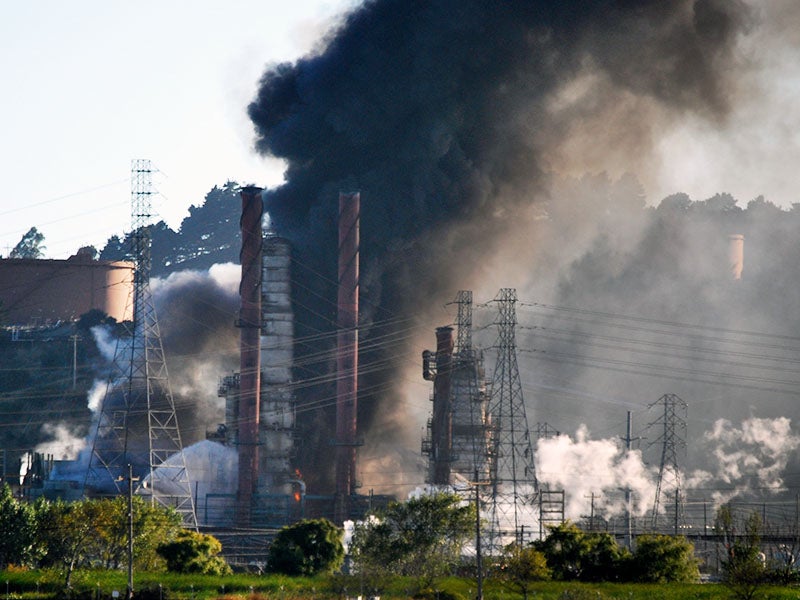EPA delay imperils communities of color near chemical plants
African American and Latino communities will be harmed most by the EPA’s delay of a lifesaving chemical safety rule.

This page was published 8 years ago. Find the latest on Earthjustice’s work.
Pam Nixon lives in an area of West Virginia called “Chemical Valley,” where she is surrounded by facilities that handle dangerous toxic and flammable chemicals. Many times during her 65 years there she’s had to shelter in place, tape up windows and huddle in her home after being alerted about a chemical leak nearby.
For years, Nixon has advocated for better protections against toxic chemicals. She thought all her hard work had paid off in January, when the EPA finalized its Chemical Disaster Rule—an overhaul of chemical plant standards that would help prevent accidental chemical release emergencies. But last week, EPA Administrator Scott Pruitt decided to illegally delay implementation of the rule for two years, putting people’s lives at risk while the agency reconsiders the very existence of these protections.
Nixon is not alone in living under the shadow of chemical accidents. According to the EPA, more than 1,500 chemical safety accidents occurred between 2004 and 2013 that caused property damage, injuries and even death. In 2008, an explosion at a pesticide plant plant in West Virginia killed two people and injured eight. In 2012, 15,000 people sought medical treatment following a fire and explosion at a Chevron refinery in Richmond, Calif. And an explosion at a West Texas fertilizer plant in 2014 killed 15 people, including firefighters, and injured 160.
According to the EPA, more than 1,500 chemical safety accidents occurred between 2004 and 2013 that caused property damage, injuries and even death.
This safety issue particularly threatens African Americans and Latinos, who are more likely to live in close proximity to chemical facilities. In fact, African Americans are 75 percent more likely to live near industrial chemical facilities than the average citizen, according to a national report by the Environmental Justice and Health Alliance for Chemical Policy Reform. The percentage of Latinos living in proximity to dangerous chemical plants is also shockingly high, at 60 percent more than the national average.
According to Nixon, this disparity makes the voices of communities of color and low-income communities particularly relevant.
“These chemical plants—like other polluting facilities—tend to be disproportionately located near low-income and minority communities,” says Nixon. “Perhaps that’s because the companies that run them don’t think our voices will be heeded by the government. We can’t let that happen.”
“These chemical plants—like other polluting facilities—tend to be disproportionately located near low-income and minority communities,” says Nixon.
The Chemical Disaster Rule would require 12,500 oil, gas and chemical facilities to apply accident prevention and emergency response measures to their facilities, and it would ensure that the facilities with the most serious accident records consider establishing stronger safeguards to prevent death, injury and chemical exposure to workers and community members. The rule would also require improved emergency preparedness and information sharing, to protect first responders and ensure that vulnerable communities are not left in the dark about ways to prevent and reduce harm from chemical accidents. The rule was finalized after years of careful consideration and significant public input. Pruitt’s delay undermines years of hard work by coalitions and advocates like Nixon, and it prevents communities of color who live near dangerous facilities from getting the protections they need.
On June 22, Earthjustice filed litigation on behalf of 13 local and national environmental groups, as well as threatened community groups across the country, to stop the EPA from delaying needed updates to the Chemical Disaster Rule. The United Steelworkers Union has also moved to intervene in support of the rule, to protect workers from danger and stand in solidarity with first-responders and threatened community groups.
While Earthjustice goes to court to represent communities threatened by Pruitt’s delay of the rule, Nixon continues to fight.
“This rule should not be delayed any further,” she said recently in an op-ed for The Hill. “It most certainly should not be killed. People in communities like mine near these plants need these safeguards desperately.”
Earthjustice’s Washington, D.C., office works at the federal level to prevent air and water pollution, combat climate change, and protect natural areas. We also work with communities in the Mid-Atlantic region and elsewhere to address severe local environmental health problems, including exposures to dangerous air contaminants in toxic hot spots, sewage backups and overflows, chemical disasters, and contamination of drinking water. The D.C. office has been in operation since 1978.